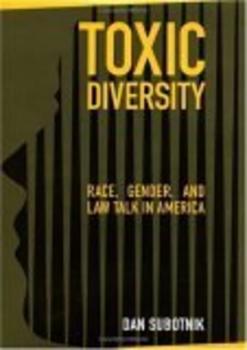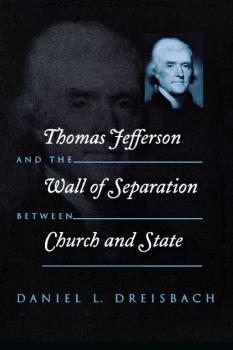ТОП просматриваемых книг сайта:
Юриспруденция, право
Различные книги в жанре Юриспруденция, право, доступные для чтения и скачиванияАннотация
Toxic Diversity offers an invigorating view of race, gender, and law in America. Analyzing the work of preeminent legal scholars such as Patricia Williams, Derrick Bell, Lani Guinier, and Richard Delgado, Dan Subotnik argues that race and gender theorists poison our social and intellectual environment by almost deliberately misinterpreting racial interaction and data and turning white males into victimizers. Far from energizing women and minorities, Subotnik concludes, theorists divert their energies from implementing America's social justice agenda.Insisting, in the words of James Baldwin, that “not everything that is faced can be changed, but nothing can be changed until it is faced,” and that thoughtful Americans regardless of race and gender can handle frank conversations about difficult topics, Subotnik’s critique of race and gender theory pulls no punches as it confronts such inflammatory issues as single parenthood, the merit system in academic and business settings, gender privilege in the classroom, and crime.
Аннотация
Why do people commit crimes? How do we control crime? The theories that criminologists use to answer these questions are built on a number of underlying assumptions, including those about the nature of crime, free will, human nature, and society. These assumptions have a fundamental impact on criminology: they largely determine what criminologists study, the causes they examine, the control strategies they recommend, and how they test their theories and evaluate crime-control strategies. In Toward a Unified Criminology, noted criminologist Robert Agnew provides a critical examination of these assumptions, drawing on a range of research and perspectives to argue that these assumptions are too restrictive, unduly limiting the types of «crime» that are explored, the causes that are considered, and the methods of data collection and analysis that are employed. As such, they undermine our ability to explain and control crime. Agnew then proposes an alternative set of assumptions, drawing heavily on both mainstream and critical theories of criminology, with the goal of laying the foundation for a unified criminology that is better able to explain a broader range of crimes.
Аннотация
No phrase in American letters has had a more profound influence on church-state law, policy, and discourse than Thomas Jefferson’s “wall of separation between church and state,” and few metaphors have provoked more passionate debate. Introduced in an 1802 letter to the Danbury, Connecticut Baptist Association, Jefferson’s “wall” is accepted by many Americans as a concise description of the U.S. Constitution’s church-state arrangement and conceived as a virtual rule of constitutional law. Despite the enormous influence of the “wall” metaphor, almost no scholarship has investigated the text of the Danbury letter, the context in which it was written, or Jefferson’s understanding of his famous phrase. Thomas Jefferson and the Wall of Separation Between Church and State offers an in-depth examination of the origins, controversial uses, and competing interpretations of this powerful metaphor in law and public policy.
Аннотация
The Unpredictable Constitution brings together a distinguished group of U.S. Supreme Court Justices and U.S. Court of Appeals Judges, who are some of our most prominent legal scholars, to discuss an array of topics on civil liberties. In thoughtful and incisive essays, the authors draw on decades of experience to examine such wide-ranging issues as how legal error should be handled, the death penalty, reasonable doubt, racism in American and South African courts, women and the constitution, and government benefits. Contributors: Richard S. Arnold, Martha Craig Daughtry, Harry T. Edwards, Ruth Bader Ginsburg, Betty B. Fletcher, A. Leon Higginbotham, Jr., Lord Irvine of Lairg, Jon O. Newman, Sandra Day O'Connor, Richard A. Posner, Stephen Reinhardt, and Patricia M. Wald.
Аннотация
Choice Outstanding Academic Title 2003 Personal rights, such as the right to procreate—or not—and the right to die generate endless debate. This book maps out the legal, political, and ethical issues swirling around personal rights. Howard Ball shows how the Supreme Court has grappled with the right to reproduce and to abort, and takes on the issue of auto-euthanasia and assisted suicide, from Karen Ann Quinlan through Kevorkian and just recently to the Florida case of the woman who was paralyzed by a gunshot from her mother and who had the plug pulled on herself. For the last half of the twentieth century, the justices of the Supreme Court have had to wrestle with new and difficult life and death questions for them as well as for doctors and their patients, medical ethicists, sociologists, medical practitioners, clergy, philosophers, law makers, and judges. The Supreme Court in the Intimate Lives of Americans offers a look at these issues as they emerged and examines the manner in which the men and women of the U.S. Supreme Court addressed them.
Аннотация
The symptoms of the crisis of the U.S. media are well-known—a decline in hard news, the growth of info-tainment and advertorials, staff cuts and concentration of ownership, increasing conformity of viewpoint and suppression of genuine debate. McChesney's new book, The Problem of the Media , gets to the roots of this crisis, explains it, and points a way forward for the growing media reform movement.Moving consistently from critique to action, the book explores the political economy of the media, illuminating its major flashpoints and controversies by locating them in the political economy of U.S. capitalism. It deals with issues such as the declining quality of journalism, the question of bias, the weakness of the public broadcasting sector, and the limits and possibilities of antitrust legislation in regulating the media. It points out the ways in which the existing media system has become a threat to democracy, and shows how it could be made to serve the interests of the majority.McChesney's Rich Media, Poor Democracy was hailed as a pioneering analysis of the way in which media had come to serve the interests of corporate profit rather than public enlightenment and debate. Bill Moyers commented, «If Thomas Paine were around, he would have written this book.» The Problem of the Media is certain to be a landmark in media studies, a vital resource for media activism, and essential reading for concerned scholars and citizens everywhere.
Аннотация
Over the past two decades, concern about adolescent sex offenders has grown at an astonishing pace, garnering heated coverage in the media and providing fodder for television shows like Law & Order . Americans’ reaction to such stories has prompted the unquestioned application to adolescents of harsh legal and clinical intervention strategies designed for serious adult offenders, with little attention being paid to the psychological maturity of the offender. Many strategies being used today to deal with juvenile sex offenders—and even to define what criteria to use in defining «juvenile sex offender»—do not have empirical support and, Frank C. DiCataldo cautions, may be doing more harm to children and society than good. The Perversion of Youth critiques the current system and its methods for treating and categorizing juveniles, and calls for a major reevaluation of how these cases should be managed in the future. Through an analysis of the history of the problem and an empirical review of the literature, including specific cases and their outcomes, DiCataldo demonstrates that current practices are based more on our collective fears and moral passions than on any supportive science or sound policy.
Информация о книге
Автор произведения Frank C. DiCataldo
Жанр Юриспруденция, право
Серия Psychology and Crime
Аннотация
Tort law is the body of law governing negligence, intentional misconduct, and other wrongful acts for which civil actions can be brought. The conventional wisdom is that the rules, concepts, and structures of tort law are neutral and unbiased, free of considerations of gender and race.In The Measure of Injury , Martha Chamallas and Jennifer Wriggins prove that tort law is anything but gender and race neutral. Drawing on an in-depth analysis of case law ranging from the Jim Crow South to the 9/11 Victim Compensation Fund, the authors demonstrate that women and minorities have been under-compensated in tort law and that traditional biases have resurfaced in updated forms to perpetuate patterns of disparate recovery based on race and gender. Grappling with tort theory, the intricacies of legal doctrine and the practical effects of legal rules, The Measure of Injury is a unique treatise on torts that uncovers the public and cultural dimensions of this always-controversial domain of private law.
Аннотация
In this authoritative volume, race and ethnicity are themselves considered as central organizing principles in why, how, where and by whom crimes are committed and enforced. The contributors argue that dimensions of race and ethnicity condition the very laws that make certain behaviors criminal, the perception of crime and those who are criminalized, the determination of who becomes a victim of crime under which circumstances, the responses to laws and crime that make some more likely to be defined as criminal, and the ways that individuals and communities are positioned and empowered to respond to crime. Contributors: Eric Baumer, Lydia Bean, Robert D. Crutchfield, Stacy De Coster, Kevin Drakulich, Jeffrey Fagan, John Hagan, Karen Heimer, Jan Holland, Diana Karafin, Lauren J. Krivo, Charis E. Kubrin, Gary LaFree, Toya Z. Like, Ramiro Martinez, Jr., Ross L. Matsueda, Jody Miller, Amie L. Nielsen, Robert O'Brien, Ruth D. Peterson, Alex R. Piquero, Doris Marie Provine, Nancy Rodriguez, Wenona Rymond-Richmond, Robert J. Sampson, Carla Shedd, Elizabeth Trejos-Castillo, Avelardo Valdez, Alexander T. Vazsonyi, María B. Vélez, Geoff K. Ward, Valerie West, Vernetta Young, Marjorie S. Zatz.
Аннотация
Among the many important tools feminist legal theorists have given scholars is that of anti-essentialism: all women are not created equal, and privilege varies greatly by circumstances,particularly that of race and class. Yet at the same time, feminist legal theory tends to view men through an essentialist lens, in which men are created equal. The study of masculinities, inspired by feminist theory to explore the construction of manhood and masculinity, questions the real circumstances of men, not in order to deny men’s privilege but to explore in particular how privilege is constructed, and what price is paid for it.In this groundbreaking work, feminist legal theorist Nancy E. Dowd exhorts readers to apply the anti-essentialist model—so dominant in feminist jurisprudence—to the study of masculinities. She demonstrates how men’s treatment by the law and society in general varies by race, economic position, sexuality, and other factors. She applies these insights to both boys and men, examining how masculinities analysis exposes both privilege and subordination. She examines men’s experienceof fatherhood and sexual abuse, and boys’ experience in the contexts of education and juvenile justice. Ultimately, Dowd calls for a more inclusive feminist theory, which, by acknowledging the study of masculinities, can broaden our understanding of privilege and subordination.










